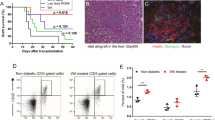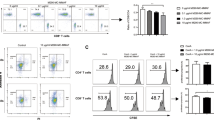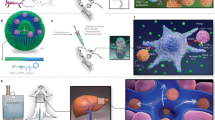Abstract
Calcineurin inhibitors such as cyclosporine A and FK506 have been used for transplant therapy and treatment of autoimmune diseases. However, the inhibition of calcineurin outside the immune system has a number of side effects, including hyperglycemia. In the search for safer drugs, we developed a cell-permeable inhibitor of NFAT (nuclear factor of activated T cells) using the polyarginine peptide delivery system1,2. This peptide provided immunosuppression for fully mismatched islet allografts in mice. In addition, it did not affect insulin secretion, whereas FK506 caused a dose-dependent decrease in insulin secretion. Cell-permeable peptides can thus provide a new strategy for drug development and may eventually be useful clinically.
This is a preview of subscription content, access via your institution
Access options
Subscribe to this journal
Receive 12 print issues and online access
$209.00 per year
only $17.42 per issue
Buy this article
- Purchase on Springer Link
- Instant access to full article PDF
Prices may be subject to local taxes which are calculated during checkout




Similar content being viewed by others
Notes
NOTE: In the version of this article originally published online, the peptide sequences in the first sentence of the Methods section, "Peptide synthesis," was printed incorrectly. The correct sequences are 11R-VIVIT, RRRRRRRRRRR-GGG-MAGPVIVITGPHEE; and 11R-VEET, RRRRRRRRRRR-GGG-MAGPPHIVEETGPHVI. The mistake has been corrected for the HTML and print versions of the article.
References
Lindgren, M., Hällbrink, M., Prochiantz, A & Langel, Ü Cell-penetrating peptides. Trends Pharmacol. Sci. 21, 99–103 (2000).
Schwarze, S.R. & Dowdy, S.F. In vivo protein transduction: intracellular delivery of biologically active proteins, compounds and DNA. Trends Pharmacol. Sci. 21, 45–48 (2000).
Chellaiah, M.A. et al. Rho-A is critical for osteoclast podosome organization, motility, and bone resorption. J. Biol. Chem. 275, 11993–20002 (2000).
Dostmann, W.R. et al. Highly specific, membrane-permeant peptide blockers of cGMP-dependent protein kinase Iα inhibit NO-induced cerebral dilation. Proc. Natl. Acad. Sci. USA 97, 14772–14777 (2000).
Gallouzi, I.E. & Steitz, J.A. Delineation of mRNA export pathways by the use of cell-permeable peptides. Science 294, 1895–1901 (2001).
Schwarze, S.R., Ho, A., Vocero-Akbani, A. & Dowdy, S.F. In vivo protein transduction: delivery of a biologically active protein into the mouse. Science 285, 1569–1572 (1999).
Rao, A., Luo, C. & Hogan, P.G. Transcription factors of the NFAT family: regulation and function. Annu. Rev. Immunol. 15, 707–747 (1997).
Crabtree, G.R. Generic signals and specific outcomes: signaling through Ca2+, calcineurin, and NF-AT. Cell 96, 611–6114 (1999).
Sigal, N.H. et al. Is cyclophilin involved in the immunosuppressive and nephrotoxic mechanism of action of cyclosporin A? J. Exp. Med. 173, 619–628 (1991).
Platz, K.P. et al. Nephrotoxicity following orthotopic liver transplantation. A comparison between cyclosporine and FK506. Transplantation 58, 170–178 (1994).
Pascual, M. et al. Chronic rejection and chronic cyclosporin toxicity in renal allografts. Immunol. Today 19, 514–519 (1998).
Hojo, M. et al. Cyclosporine induces cancer progression by a cell-autonomous mechanism. Nature 397, 530–534 (1999).
Aramburu, J. et al. Affinity-driven peptide selection of an NFAT inhibitor more selective than cyclosporin A. Science 285, 2129–2133 (1999).
Wender, P.A. et al. The design, synthesis, and evaluation of molecules that enable or enhance cellular uptake: peptoid molecular transporters. Proc. Natl. Acad. Sci. USA 97, 13003–13008 (2000).
Futaki, S. et al. Arginine-rich peptides. An abundant source of membrane-permeable peptides having potential as carriers for intracellular protein delivery. J. Biol. Chem. 276, 5836–5840 (2001).
Matsushita, M. et al. A high-efficiency protein transduction system demonstrating the role of PKA in long-lasting long-term potentiation. J. Neurosci. 21, 6000–6007 (2001).
Matsui, H., Tomizawa, K., Lu, Y.-F. & Matsushita, M. Protein therapy: in vivo protein transduction by polyarginine (11R) PTD and subcellular targeting delivery. Curr. Protein Pept Sci. 4, 151–157 (2003).
Odocha, O. et al. Posttransplant diabetes mellitus in African Americans after renal transplantation under FK506 immunosuppression. Transplant. Proc. 25, 2433–2434 (1993).
Okitsu, T. et al. Recurrent autoimmunity accelerates destruction of minor and major histoincompatible islet grafts in nonobese diabetic (NOD) mice. Am. J. Transplantation 1, 138–145 (2001).
Redmon, J.B. et al. Effects of tacrolimus (FK506) on human insulin gene expression, insulin mRNA levels, and insulin secretion in HIT-T15 cells. J. Clin. Invest. 98, 2786–2793 (1996).
Todt, J. et al. Repeated intratracheal challenge with particulate antigen modulates murine lung cytokines. J. Immunol. 164, 4037–4047 (2000).
Acknowledgements
We thank A. Rao and P. Hogan (Harvard University) for providing the GFP-NFAT-1 plasmid and other reagents; S. Bonner-Weir (Harvard University) and T. Takahashi (Tokyo University) for discussion and comments on this manuscript; and T. Ogawa and T. Shirai for technical assistance. This work was supported by a Grant-in-Aid for Scientific Research on Priority Areas (medical genome science) from the Ministry of Education, Culture, Sports, Science and Technology of Japan, by the Life Science Project of 21st Century, Japan, and by the Regional Research & Development Consortium Project.
Author information
Authors and Affiliations
Corresponding author
Ethics declarations
Competing interests
The authors declare no competing financial interests.
Rights and permissions
About this article
Cite this article
Noguchi, H., Matsushita, M., Okitsu, T. et al. A new cell-permeable peptide allows successful allogeneic islet transplantation in mice. Nat Med 10, 305–309 (2004). https://doi.org/10.1038/nm994
Received:
Accepted:
Published:
Issue Date:
DOI: https://doi.org/10.1038/nm994
This article is cited by
-
Activation of NFAT by HGF and IGF-1 via ARF6 and its effector ASAP1 promotes uveal melanoma metastasis
Oncogene (2023)
-
The optimized core peptide derived from CABIN1 efficiently inhibits calcineurin-mediated T-cell activation
Experimental & Molecular Medicine (2022)
-
In vivo evaluation of GG2–GG1/A2 element activity in the insulin promoter region using the CRISPR–Cas9 system
Scientific Reports (2021)
-
Mutations in the C1 element of the insulin promoter lead to diabetic phenotypes in homozygous mice
Communications Biology (2020)
-
The rat pancreatic body tail as a source of a novel extracellular matrix scaffold for endocrine pancreas bioengineering
Journal of Biological Engineering (2018)



